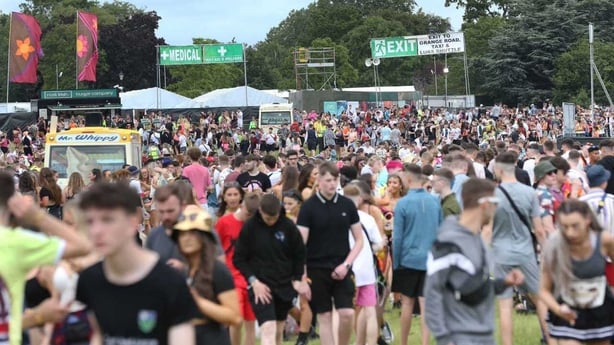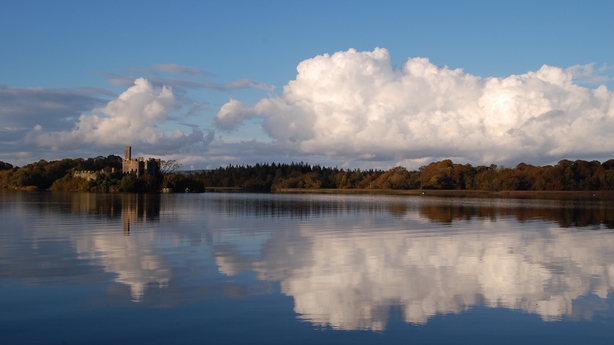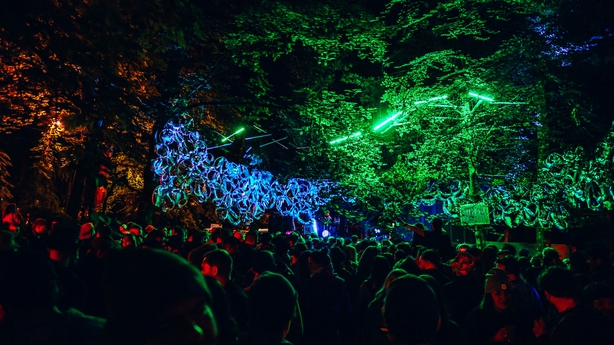Festival season is well underway, with this year having perhaps the biggest line-up of live music events ever seen in the country.
This, in part, is following a global trend in the music industry.
“The model used to be that you bought records, you bought CDs, you bought cassettes and you didn’t go live music, you didn’t spend as much on live music,” says Michael Murphy, humanities and arts lecturer at the Institute of Art, Design and Technology in Dún Laoghaire, who specialises in the music industry.
“Now we’ve inverted that business model – live music is now the absolute driver of the music economy.
“People want to go to gigs because it’s unmissable. It’s irreplaceable. It’s a one-off.”
But even accounting for the wider industry dynamic, Ireland seems to be punching well above its weight on the live music scene.
Longitude, All Together Now, Forbidden Fruit, Sea Sessions, Beyond The Pale, Night & Day and Electric Picnic – to name just a few – have filled up this summer’s music schedule.
And they’re drawing in somewhere in the region of 200,000 gig-goers between them, despite stiff competition from gig series in numerous locations including Dublin’s St Anne’s Park, Malahide Castle and Trinity College; Cork’s Marquee and Galway Airport.
That’s not to mention big standalone gigs from acts like Taylor Swift, Bruce Springsteen, Pink and Coldplay.
“There’s a huge demand, and there’s a huge desire in Ireland for collective socialisation,” says Murphy.
That, he says, is proven through the popularity of all manner of live events here – from Bloom to the Ploughing Championships.
“That drives a huge appetite for live music – be it mega events, like Taylor Swift or, in our case, in festivals,” he says.
And, of course, live music has always been central to the traditional and folk music scene.
That means Ireland’s love affair with the festival began long before the global trend towards big, live events.
From Macroom to Stradbally
The origins of the modern Irish music festival can arguably be traced back to the Macroom Mountain Dew Festival, first held in 1976, with the Horslips and Marianne Faithfull topping the bill.
In 1977 Dalymount Park hosted what was billed as ‘Dublin’s first open air rock festival’; headlined by Thin Lizzy, with the Boomtown Rats appearing as one of the support acts.
The following year the first Lisdoonvarna Folk Festival took place, as well as the Anti-Nuclear Power Show in Carnsore Point.
According to Murphy these events, coupled with the emergence of more promising Irish acts like U2 and the added exposure given to pop and rock music through the launch of 2FM, quickly led to a festival boom.
Slane held its first concert in 1981 and, eventually, Féile and Sunstroke joined the summer schedule, with each running for a number of years through the 1990s.
And while most of those early festivals eventually came to an end, they formed the foundations for the vibrant scene that we see today.
“We have a very serious talent pool to dip into for all the basic things that people might dismiss, but are of huge consequence, like picking up the litter, like stewarding, like showing people where they need to be, like looking after the artist,” said Murphy.
“We’ve a huge range of people who’ve got experience doing that, we’ve got a huge talent pool of people who have successfully put on mega-events… we’re definitely outliers in how common these events and how good they are.”
Another thing that has evolved since the 1970s is the general attitude towards festivals – and the nature of the audience that’s interested in going to them.
More than music

Where in the past music festivals were something of a rite of passage for young people – or something of a counter-cultural get-together – today they have a much broader appeal.
Part of that is down to the sheer volume of events, with different festivals now catering to almost every type of music lover.
But it is also down to what’s being offered at the festivals themselves.
Modern festivals are no longer the preserve of hardcore fans who are willing to rough it to see their favourite acts. The facilities on offer are now generally quite good, with luxurious ‘glamping’ options also available to those willing or able to pay.
They’re also now more than just music events; they’re part of the experience economy.
That means comedy acts, topical discussion, theatre, meditation areas and kid-friendly entertainment are now all on offer, alongside the headline acts.
One of Ireland’s youngest music festivals is a prime example of that.
Night & Day Festival, which is held in Roscommon’s Lough Key Forest Park, is centered around a musical line-up; with this year’s edition headlined by Bell X1 and Damien Dempsey.
However it also offered attendees spa treatments and yoga – and a full schedule of family-friendly activities.
“One of the big things that was successful from year one was our family-friendly area,” says Craig Hughes, organiser of Night & Day. “I noticed at other festivals that there would maybe be some kind of token kids area – but this is actually a fully, well-thought out programme to keep kids engaged.
“We don’t want to be a kid’s festival – that’s not what we want to be – but it’s an important factor for us.”
Indie music scene

Night & Day debuted in 2022, bringing a festival to the musically under-served Midlands.
The process has represented a steep learning curve for Hughes, who’s day job is political editor of the Irish Daily Mail.
“It is a crazy idea to go ahead and do it – and it’s one of those things where if you probably knew everything that was involved you mightn’t go ahead and do it,” he says.
Ultimately it was a love of music that drove Hughes on, with his co-founders – two of his uncles – also bringing their experience of putting together live events.
And while, as a founder, Hughes can be involved in every aspect of the event, his main responsibility is around media, partnerships and filling the line-up.
“The hard part is there’s no price list [for acts],” he said. “It doesn’t say that Villagers are X amount – you go and negotiate and they maybe work out a fee based on how many people you might have there and things like that.
“It’s a complex formula and no-one tells you what the answer is initially, so that takes a little working out and you have to learn what you should be providing and what you shouldn’t be providing.”
In its first year one of the headliners requested a grand piano for his set; an unexpected request that Hughes described as a “nightmare” to fulfill.
But, somehow, they managed to source one.
“It’s all the little extras that touring agents and tour managers will try to put on you – you’ve got to learn what you should be providing and what just isn’t acceptable for a festival of your size,” he says.
Launching a brand new festival is an inherently risky venture – not least because of the amount of unknowns involved.
Organisers can at best estimate the general level of demand for the event, and how much of a draw the acts they book will be. Getting pricing right is also an inexact science, as is putting together the right amenities for gig-goers.
They essentially have to believe that, if they build it, crowds will come.
“The nightclub industry is dying here, particularly for the music I like. I know a lot of my peer group will only get the type of music they want at festivals,” says Hughes.
Though there was a far more practical prompt for Night & Day’s first year.
“The reason we went ahead in the first place was purely because of geography – there was no music festival in what is called Ireland’s Hidden Heartlands,” he says.
The fact that Night & Day launched in the aftermath of pandemic lockdowns further complicated their arithmetic, while its change of date and venue last year also made it harder for organisers to settle into their stride.
But with three years now under their belt – and valuable data from post-event surveys – Hughes says they are finally on steadier ground.
“We can look at our age demographic – I think 50% are between 40 and 50, with about 20% falling on the other sides of that,” he said. “When you know that, that gives you a good idea from your programming perspective and who you’re building the festival for in terms of line-up.”
Having hosted around 3,000 people last year, next year’s event is going to increase its capacity to 5,000.
That’s an important threshold, he says, because anything beyond that requires going through a licensing process that’s akin to planning permission.
But the bigger crowd will still create additional challenges, like the need for more camping and caravan space, more food, drink and toilet facilities – and a second stage.
That gives organisers a long to-do list to work through in order to make the 2025 festival a reality.
Hughes says they will likely start to reveal their line-up in Novemer, meaning they’re already having initial conversations with agents and artists about performing.
Cashflow is king

Cashflow is also a major challenge for events like these.
Deposits need to be paid well in advance to secure everything from acts to infrastructure.
Festivals will try to drum up strong advanced ticket sales by teasing its line-up over the coming months, but it’s a struggle to generate the required revenue at such an early stage.
And the costs involved are only going one way.
“You’ve got the permit and the licence, you’ve got the venue rental, you’ve got insurance, you’ve got marketing and advertising,” says Murphy. “You’ve got to rent gear – the music equipment – you’ve got to rent the portable toilets, you’ve got to have security, you’ve got to have stage and lighting, you’ve got to have make sure that there’s electricity – and electricity for a festival is eye-watering. In some cases you might have to build a road or a pathway because it’s not accessible from a main road.”
The scale of that burden has already seen the UK’s independent festival sector come under huge pressure – with big players like Live Nation and AEG becoming increasingly dominant.
“The big corporate players have huge advantages, because they’re also booking Reading, Leeds and another large number of events over that summer,” he says. “They can say ‘here’s 20 dates in Europe for you’ and that’s really attractive to a manager.
“They might even get a better price from that act than you would if you were doing it as a once-off.”
That scale also insulates them against the big risks that might face a festival – like adverse weather.
“If Reading gets rained off, it’s okay because I might own a stake in Glastonbury, or I certainly own a couple of festivals elsewhere in Britain, so you’re protected against the events that might sink a one-time operator,” says Murphy.
Boomtime for boutiques

But while the big players are certainly at the forefront of the Irish festival industry, there still seems to be space for the smaller guys too.
Murphy says that there are a lot of smart, innovative organisers in the Irish market – who have the advantage of having a deep understanding of the niche they’re trying to serve.
“The costs are monumental – and that’s why, sometimes, these micro and niche festivals, they’re very DIY, they’re very inventive, they’re very creative and they keep their costs low,” he says.
That’s important because the margin on these kinds of events is slim – and getting slimmer.
Murphy says that, in the past, events would generally need to sell 85% of their tickets before they turned a profit. Today that’s more likely to be 98%.
That’s an incredibly risk position to be in – and it’s forced organisers to work harder to generate other revenues.
Putting a few sponsors on the poster and taking fees from concessions vendors is no longer enough – now exclusive deals with individual food and drink brands are par for the course.
But big companies are often willing to pay significant sums in return for deep integration with the event.
That’s made branded zones and stages a common feature of the modern festival.
Next week’s All Together Now festival has stages sponsored by Guinness, Jameson, Smirnoff and Dingle Gin.
Meanwhile Electric Picnic has an extensive partnership with Three, which extends to a sponsored stage and a ‘Charge & Chill’ area that gives free treats – like ice-cream – to the mobile operator’s customers.
“Festival provides a very unique opportunity to link your brand with a life-affirming, or even life-changing experience,” says Murphy.
Venues, State and public bodies can also be an important support for budding events.
“Thankfully Coillte and [Roscommon] council, who are the two main shareholders in Lough Key Forest Park, have come on as our main partners and they’ve been a really great driving force behind us,” says Hughes. “Lough Key are in the process of pushing forward a new masterplan and trying to double visitor numbers – we see ourselves as central to that.”
All of this represents the ever-growing sophistication of the Irish festival scene – and their ever-growing importance to Irish life.
And far from demand for these events declining, the expectation is that organisers will continue to find clever ways of broadening their appeal in the years to come.
“Festivals understand you and they want your money,” says Murphy, pointing out that the recent trend in the US has seen festivals move to urban, rather than rural, locations.
“If you don’t go to them, they will miss you and they will come to you.”
